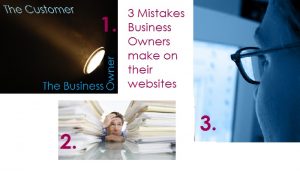 When you’re in charge of writing the copy for your own website there are some pitfalls that should be avoided – but they’re difficult to see when you’re inside the business.
When you’re in charge of writing the copy for your own website there are some pitfalls that should be avoided – but they’re difficult to see when you’re inside the business.
Let’s be honest, if you’re a business owner you are likely to be excited about what you do (if you’re not, maybe you should rethink what your business should be about). The challenge is that when given the chance to tell other people about your business it’s a bit like turning on a tap – all that stuff that you’re passionate about comes flooding out – and here lies a problem.
These are the three biggest mistakes that you can make when creating the copy to persuade people to buy your services or products:
Mistake number one
Writing about yourself and your business
Hang on a minute – isn’t that what the website is for?
Well, yes – and no.
The website is there to persuade potential clients to take action and either buy something or at least get in touch with you. People aren’t interested in you – or in what you do; they’re interested in what they get. This means that your copy needs to be focused on the reader so not:
We do this
But
You can have that.
It’s a subtle difference, but a powerful one. Remember what it’s like on the other end of this – when you meet someone and politely ask ‘So what do you do?’ you really don’t want to know exactly what they do – you want to know how what they do might help you in some way. When you hear the word ‘we’ or ‘our’ or ‘us’ you may have a polite (but probably lukewarm) interest; but the minute someone says ‘you’ your ears prick up and you start imagining yourself in the situation they’re describing.
This is called ‘engagement’. That’s what you’re aiming for on your website. So banish the word ‘we’ and replace it with ‘you’.
Mistake number two
Information overload
When someone arrives on your website they want to know if you’ve got what they’re looking for. They don’t need to know how you do it, the manufacturing process, the technical jargon and so on. This means that you need to cut what you write down to the bare bones – and these bones should be focused on the benefits that the reader will experience, the problems that will disappear and the positive changes they’ll experience by choosing to work with your business.
We’re back to keeping your passion in check. It’s easy to start explaining everything in detail, but it’s worth asking a few of your existing customers what kind of information they would be looking for if they were just starting to look for your services or products. Asking existing clients is a good way to get them involved and remind them how customer-focused you are!
Web pages should be no longer than 250 words, ideally just under 200. If your SEO company suggests writing much longer page, my suggestion is to write 200 words, put your call to action, then an image and then the remaining copy – which, in most instances, will only be read by the search engines.
Mistake number three
No reader guides
Eh? What’s a reader guide?
OK – when you arrive on a web page and there are four paragraphs of copy, no headlines, no subheaders, no bullet points, nothing that stands out – how likely are you to get started?
No? Very few people really want to read online. They do want to find information though so it makes life easier if your message has guides. This means that, if people are scanning over the page quickly there are bits of text that they’ll pick up on and will tell them if this is something they need to stop at and read more carefully. For instance:
The headline – not the page name; but something that captures the attention of the reader at the beginning
Sub headings – these break up the text and stop the eye as it’s scanning down the copy. Even short pieces of copy benefit from these to re-engage the reader at key points.
Bullet-point lists – people like reading lists so if you’ve got a few key pieces of information, turning them into a list is a smart way to get people to pay a bit more attention.
Words or phrases in bold – really clever copywriters can pick a number of key phrases out of the page, turn they into bold text and, if the reader only reads those words they still get the message. Bold text, even within a paragraph just makes things stand out.
Images – a page full of text with no images looks really lifeless. Add relevant images to give the page more energy. However, do remember that people read from left to right and position your image to the right of the copy so people read into it, not away from it.
Your assignment, if you choose to accept it …
Review your website to see if you’ve managed to avoid these pitfalls. It’s worth looking at any other material that you hand out to clients or customers too – don’t put obstacles between your message and your audience.
